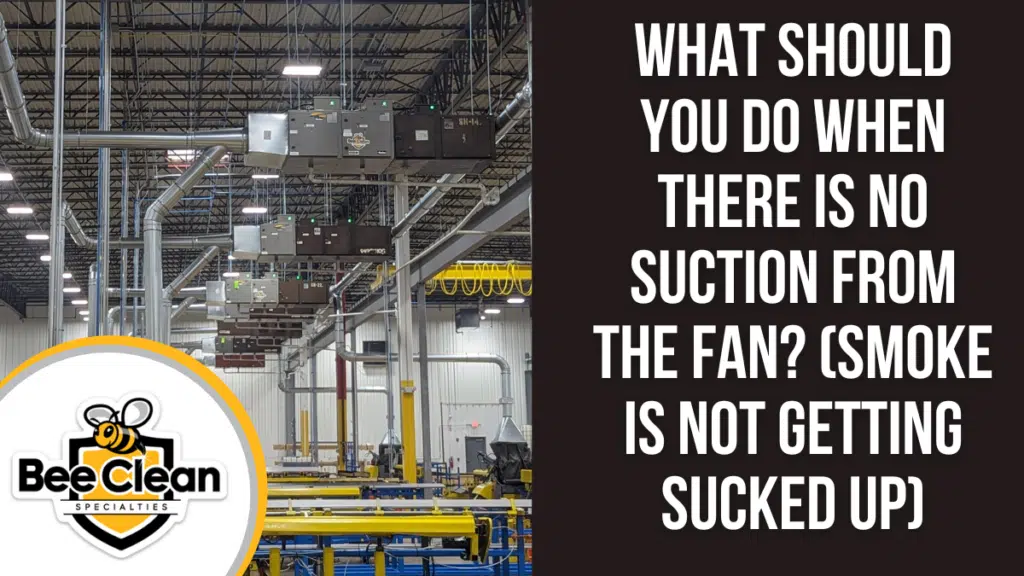What Should You do When There is no Suction From the Fan? (Smoke is not Getting Sucked up)

Why is my air cleaner not sucking up the smoke?
One of our most common service request calls is the air cleaner is not sucking. Whether it is a SmogHog, Absolent, Mistbuster, Trimist, or some other type of air cleaner, there are many reasons an air cleaner might have a highly reduced or complete lack of suction. Here is a list of a few of the things that you can check.
Blown Fuse/Tripped Thermal Relay: If a relay has been tripped or a fuse is blown, it must be reset or replaced. These can be located in the electrical box on top of the air cleaner or on the wall near the switch for that air cleaner.
How to Resolve: Disconnect and lock out the power and reset the motor / replace the fuses with a time delay fuse. Always check motor amps on start up to make sure it is within motor specs. Shut down immediately after about 2 seconds if it is not dropping to within motor specs.
Bad Motor: If the motor fails, it will stop airflow. Understanding what caused the motor to fail before replacing it is essential. Replacing the motor without knowing why it failed may cause the new motor to fail if the underlying problem is unresolved.
How to Resolve: Some things that cause the motor to fail are. Issues that may have caused the incoming power to be wrong due to a blown fuse from a power failure. If the incoming power is incorrect, i.e. wrong voltage, this needs to be resolved first. If the motor is over-amped due to a recent increase in load causing it to melt down, this also should be fixed by adjusting the blower/motor ratio or using a different, larger motor.
Belt Problems: There are many different ways that a belt can affect airflow. If the belt is loose or glazed (shiny and smooth from slipping), the airflow will be reduced.
If the belt is too tight, it can cause bearings to fail prematurely, causing a reduction or stoppage in airflow. If the belt snaps or comes off the pulleys, it will completely stop airflow.
How to resolve: If the belt has snapped, it could simply be past its working lifetime and must be replaced. If it has snapped due to poor alignment or tension, those problems should be resolved before replacing the belt. When replacing a belt, ensure you have proper belt tension to maximize its lifetime and prevent damage to other components.
Reverse rotation: On three-phase motors, if one of the wires is switched, the motor will run in reverse direction; while this does not usually cause any permanent damage to the system, the way that the blowers (fans) on most air filtration systems are designed, it will cause the airflow to decrease to around 20% of what it should be. Reverse rotation is usually only a problem if the air cleaner was recently installed or had a motor replaced recently.
How to resolve: To fix a motor spinning in reverse, you need to swap the two power wires. To tell if the motor is turning in the right direction, you can feel for the suction or check motor amps. On a forward curve fan the amps will go up when going in the right direction. On a reverse incline, the motor amps go down when going in the right direction.
Plugged Prefilters/Baffles: Depending on the type of pollutant your air cleaner is collecting and the time since it was last serviced, the metal mesh prefilters or impingement baffles could become plugged/blinded. If this does happen, it will dramatically reduce airflow. Some of the applications it is most likely to occur in are water coolant or oil-based pollutants that are thick and sticky at room temperature (some types of rubber manufacturing), especially if there is also a larger contaminant being filtered out, e.g., cottonseed or dust.
How to resolve: To resolve a lack of airflow due to blinded prefilters, you simply need to remove and clean the prefilters; in most situations, this means that it is also time to clean or exchange your collection cell and ionizer as well.
Loose Pulleys/Sheaves: The pulley/sheave can become loose on the blower or motor shaft. The pulley usually becomes loose because a set screw is not tightened correctly, and the key has slipped out.
How to resolve: If you catch this problem early enough, you may be able to simply replace the key and retighten the set screw. Sometimes, it is beneficial to change the orientation of the pulley on the shaft. If this has been a problem for some time, it may have severely worn the shaft, meaning either the shaft or the whole motor/blower will need to be replaced.
Closed Dampers: Some air filtration systems include dampers, either as a fire prevention mechanism or to redirect airflow. These dampers can be vacuum, solenoid, or manually operated, as well as spring-loaded with a thermal link that acts as a trigger.
How to resolve: The first step is finding the damper(s) that is/are closed. Once located, opening them could be as simple as pulling the vane back into the open position, or finding a the control or switch for activating the air/solenoid-operated dampers. If it is a thermally linked fire damper that has shut, the thermal link will need to be replaced.